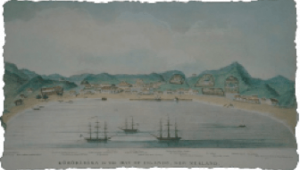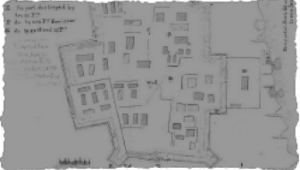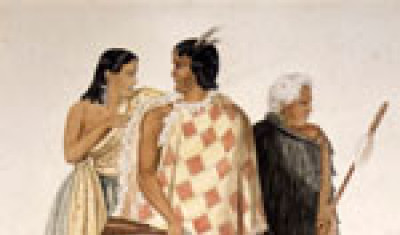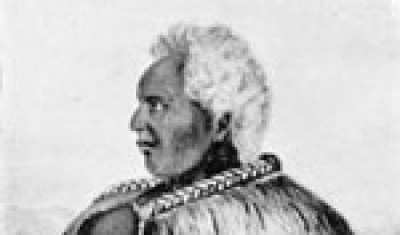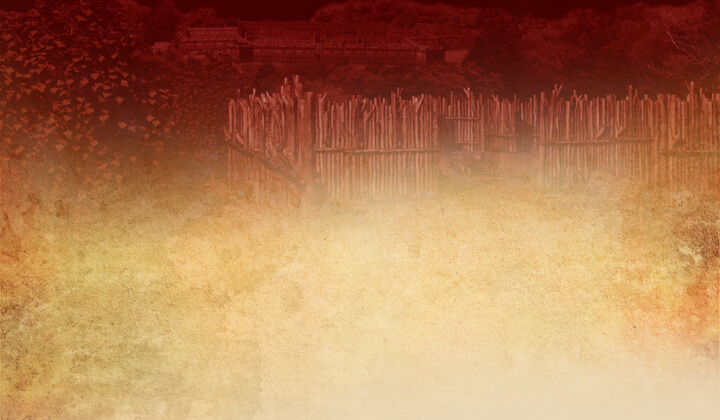
British humiliated at
Ōhaeawai (24 June 1845 - 11 July 1845)



The pā at Ōhaeawai, belonging to Heke’s ally Pene Taui, was even stronger than the pā, which the British had failed to take six weeks prior. Heke and Kawiti had been working to strengthen the defences, expecting another attack. While Heke was engaged at Te Ahuahu, Kawiti and Pene Taui continued the work at Ōhaeawai.
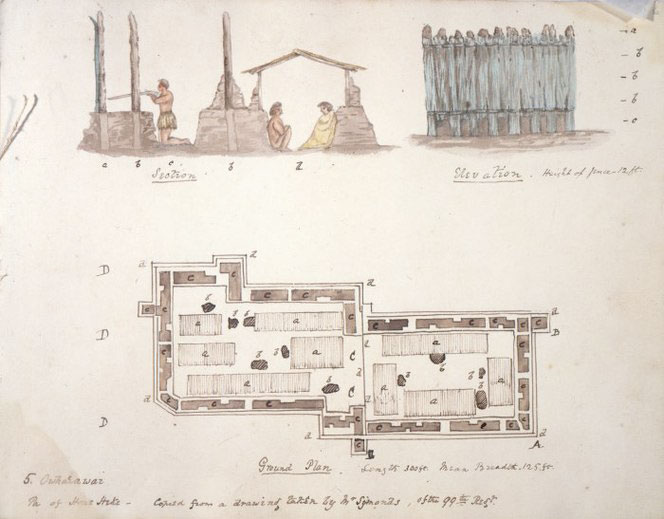
Section, elevation and ground plan of Ōhaeawai Pā.
By H. T. Biddulph from drawings by J.J. Symonds. From the Alexander Turnbull Library ref. E-137-Q-006
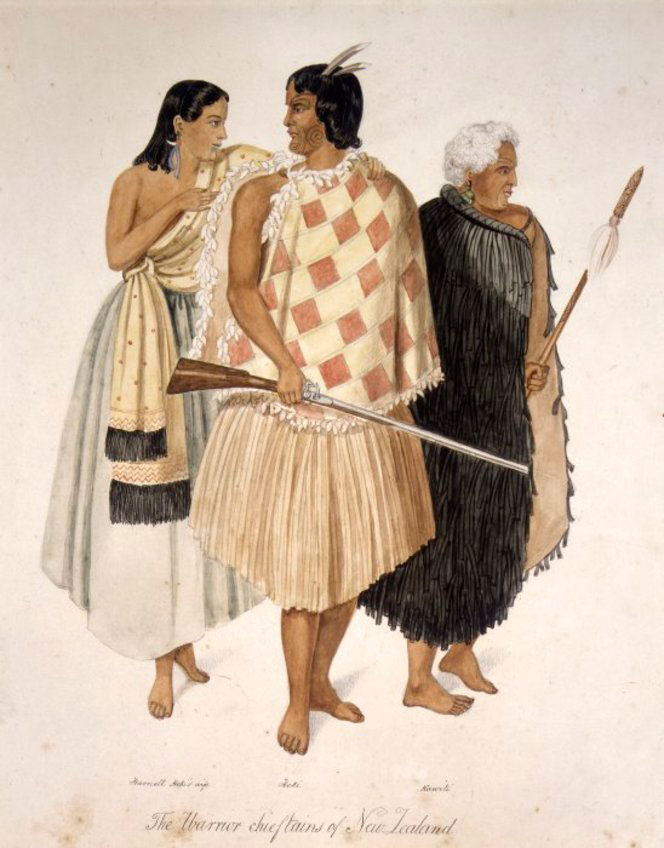
Hariata (Heke’s wife), Heke and Kawiti.
By J.J. Merrett. From the Alexander Turnbull Library. ref. C-012-019
The Ōhaeawai pā had many design features in common with Te Kahika. There were double rows of Puriri timber palisades and a well-designed system of trenches and bunkers within. The site was carefully chosen, away from important villages and food resources, and far enough inland to cause the British significant logistical difficulties.
In June 600 soldiers, marines, and volunteers returned to the Bay of Islands under Colonel Despard. Much has been written about the character of Colonel Despard, and almost none of it flattering. Shortly after the troops arrived, Despard received a visit from Tāmati Wāka Nene, who offered his assistance. Despard replied, “When I want the help of savages, I will ask for it”. Luckily, (for Despard) his answer was not translated back to Nene.
The soldiers set up camp at the Waimate mission station, much to the annoyance of the missionaries. The pā was only six miles away from Waimate, but it took some time to transport the artillery, ammunition and supplies first to Waimate and then to Ōhaeawai. Having learned a little from their experience at Te Kahika, the British bought with them four artillery pieces. However, they were greatly hampered by a lack of drays for transportation. Food supplies ran short and there were few tents. Again, the British troops were reliant upon Tāmati Wāka Nene, who provided large quantities of beef, potatoes and flour.
Heke, badly injured, was not at Ōhaeawai. The defence of the pā was in the capable hands of Kawiti and other fighting leaders. There were only about 100 warriors within the pā, preparing to stand against an attacking force many times larger.
It was 24 June by the time Despard and his men arrived at Ōhaeawai. The gun batteries were set up as soon as possible, and Despard opened fire with his brass 6-pounder cannons and 12-pounder carronades. His aims were simple: to breach the palisades and to kill the inhabitants. However, the guns were just not big enough. For seven days the British bombarded the pā without breaching the defences. Things changed on 30 June with the arrival of a massive 32-pounder cannon. Finally, the British possessed sufficient fire-power to smash the defences.
The 32-pounder was positioned in the hilltop gun battery, which was protected by a small group of soldiers. Shortly after the firing commenced, the defenders launched a daring attack from the pā. They succeeded in killing the sentry and capturing the position. The soldiers recaptured the position fairly quickly, but the warriors had time enough to take down the Union Jack flying on the gun battery flagstaff. They withdrew to the pā and hoisted the Union Jack on the flagstaff inside, underneath their own flag.
Despard was infuriated and determined to attack at all costs. He instructed the British troops to prepare for a direct assault on the pā, although the defences were still very much intact. The soldiers were ordered to charge the pā across open ground and to pull down the massive palisades with ropes and axes. The assault was disastrous. In just a few minutes 41 men lay dead and 73 more were injured.
The defenders waited until the last moment before opening fire on the mass of British troops hacking desperately at the outer defences. Kawiti’s warriors were only meters away on the other side of the palisades, safely hidden in a covered trench which ran all the way around the perimeter. They fired through carefully-placed holes in the roof of the trench. The soldiers couldn’t even see the people shooting at them, let alone defend themselves.
The enemy reserved their fire until the leading sections got within 5 paces of their outwork, we were met with such a fusillade, I can only describe it as the opening of the doors of a monster furnace. John Mitchell
At Ōhaeawai the British displayed their utter ignorance of the military prowess of Kawiti and the other chiefs. Despard, in particular, was disdainful and arrogant, incapable of regarding the Māori as a worthy foe. Kawiti and his warriors taught Despard a lesson at Ōhaeawai – a lesson reinforced by the death of 41 British soldiers.
Bitter and angry, Despard continued to bombard the pā until 9 July when the defenders, tired of the assault, left the pā under cover of darkness. The bemused British forces destroyed the pā, but could hardly claim a victory. They returned to Waimate to re-supply and plan another advance. Meanwhile, Kawiti was starting work on a new pā high on the slopes of the Tapuaeharuru Range. It would be known as Ruapekapeka – the Bat’s Nest.
